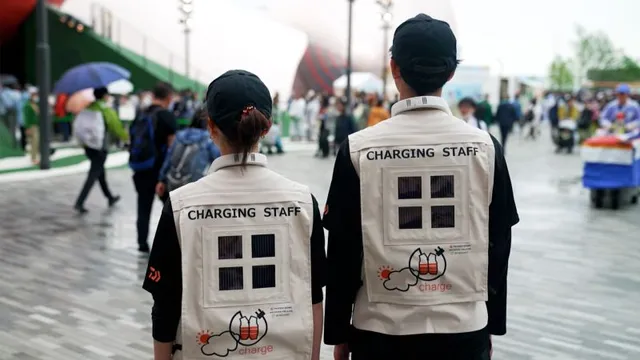
Wearable technology revolutionized with lightweight perovskite solar cells
2025-07-07 08:54- Staff at Expo 2025 in Osaka, Japan, wear utility vests powered by new perovskite solar cells.
- These solar cells achieve over 21% efficiency and are being tested for performance in different climate conditions.
- The initiative represents a significant step toward integrating solar technology into everyday items, though stability under environmental stress remains a challenge.
Express your sentiment!
Insights
Japan, particularly Osaka, has recently embraced innovative technology at Expo 2025, where lightweight wearable utility vests powered by next-generation perovskite solar cells are being used by staff to combat high summer temperatures. This groundbreaking initiative marked a significant leap in renewable energy application, showcasing how these solar cells perform efficiently in various climate conditions. They have already achieved impressive laboratory efficiencies, converting over 21% of solar energy into electricity, with the potential to harness power even in low-light environments such as indoors. Enecoat Technologies, the company leading this initiative, is currently gathering extensive data about the technology's performance against different conditions such as temperature and solar radiation. Their mobile battery is designed to fully charge within five to ten hours, catering to the increasing demand for portable energy solutions. This system not only promotes energy independence but also highlights the aesthetic possibilities of perovskites, as demonstrated by installations like the artistic facade at the Panasonic Group pavilion. Despite these advancements, challenges remain regarding the stability of perovskite solar cells under environmental stresses such as heat, moisture, and UV exposure, which can lead to a degradation of efficiency over time. Dr. Hashini Perera, a postgraduate research fellow from the University of Surrey, emphasizes that enhancing the lifespan of these materials is a significant ongoing concern. Nevertheless, the development of robust encapsulation methods has helped to mitigate potential environmental risks associated with lead leakage, providing a more promising outlook for widespread application. The evolution of perovskites comes at a critical time for Japan, which is the world's second-largest producer of iodine, a significant component in perovskite materials, and faces geographical constraints for traditional solar farm development. This novel approach of utilizing lightweight and flexible solar technology allows for installation in areas that were previously deemed unsuitable and has the potential to enhance energy generation in urban settings. The successful implementation of perovskite solutions in wearable technology may redefine the way energy is produced and consumed, moving closer to end-users and fostering sustainability in modern cities.
Contexts
The growing concern over climate change and urbanization has highlighted the urgent need for innovative energy solutions in urban environments. Among these innovations, perovskite solar cells have emerged as a groundbreaking technology capable of significantly impacting urban energy generation. Characterized by their unique crystal structure, perovskites offer advantages such as high efficiency, lower production costs, and versatile application options. Their potential to be integrated into various surfaces, including building facades and windows, presents a unique opportunity for cities to harness solar energy in previously untapped locations. These advantages position perovskites as a viable alternative to traditional silicon-based solar cells, paving the way for a more sustainable urban energy future. The integration of perovskite technology into urban energy infrastructure presents multifaceted benefits beyond just power generation. Enhanced energy efficiency in buildings can reduce dependency on fossil fuel sources, directly contributing to lower greenhouse gas emissions. Moreover, the lightweight nature and ease of fabrication of perovskite materials allow for flexible installation options. Urban planners and architects can design buildings that are not only aesthetically appealing but also energy-efficient, effectively transforming city landscapes into power-generating entities. As cities continue to expand, the incorporation of perovskite solar cells can play a quintessential role in smart city initiatives, promoting renewable energy use while enhancing urban resilience against climate-related challenges. Research on the longevity and stability of perovskite solar cells has advanced, dispelling earlier concerns about their durability. Recent advances focus on encapsulation methods that protect these cells from environmental factors, ensuring their operational lifespan meets or exceeds that of conventional solar technologies. This development is crucial for urban applications, where long-term energy generation is paramount for economic feasibility. Moreover, ongoing studies are aiming to improve the efficiency levels of perovskite solar cells, with reports indicating potential efficiencies approaching 30% in lab settings. Such efficiency gains could significantly break barriers in urban energy systems, making them more competitive and attractive to investors. The pathways toward widespread adoption of perovskite technology in urban contexts involve not only scientific advancements but also supportive policies and regulatory frameworks. Governments play a critical role in shaping the market for new technologies through incentives and funding for research and development. Collaboration between academia, industry, and public institutions can accelerate the deployment of perovskite solar solutions, helping to establish a robust ecosystem that fosters innovation. As cities aim to meet the energy demands of their growing populations while striving for sustainability, embracing the potential of perovskite solar cells will be essential in the transition towards cleaner and more efficient urban energy systems.